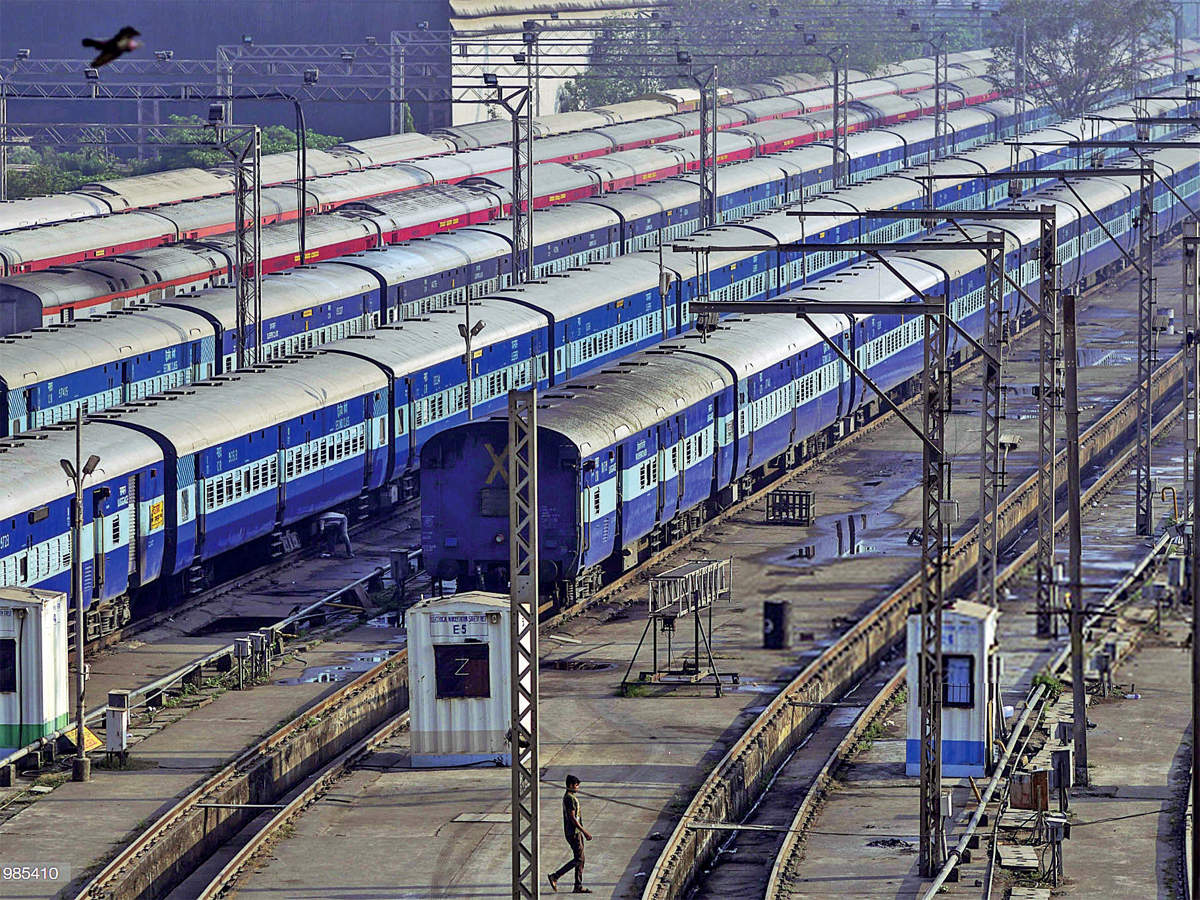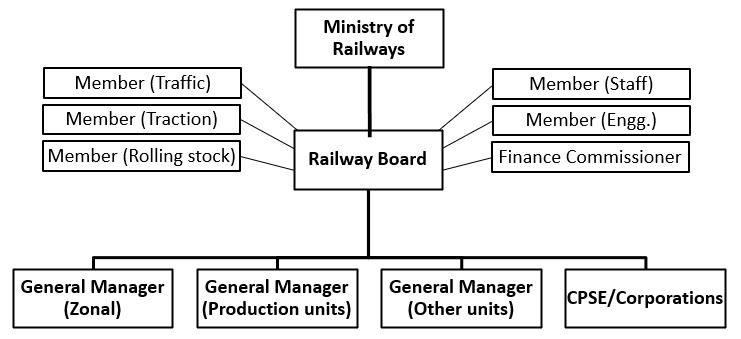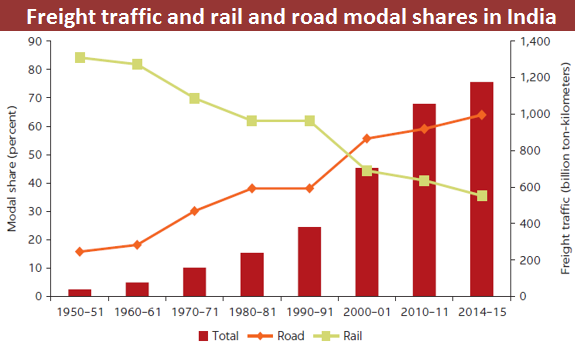PRIVATIZATION IN INDIAN RAILWAYS
2020 JUL 3
Mains >
Industry and infrastructure > Infrastructure & Investment models > Railways

IN NEWS:
The Indian Railways has invited Request for Qualifications (RFQ) for private players for the operation of 151 passenger train services on 109 Origin Destination pairs of routes.
INDIAN RAILWAYS:
- Indian Railways is the 4th largest network by size and the 8th largest employer in the world.
- It has a network of 70,000km and 8,500 stations spanning across the country, carrying over 8 billion passengers and 1.16 billion tons of freight annually.
ADMINISTRATIVE STRUCTURE OF RAILWAYS:
- The Railways is headed by a seven-member Railway Board.
- The country is divided into 18 railway zones, headed by General Managers who report to the Railway Board. South Coast Railway Zone is the most recently formed zone (2019).
- It also owns various subsidiaries related to rail transport, such as:
- IRFC, RITES, IRCON (Financing, construction and project implementation)
- IRCTC (Catering and tourism)
- CRIS, RCIL (Passenger and freight train operation)
- DFCCIL, PRCL (Rail infrastructure)
- KRCL, CONCOR (Passenger and freight train operations)
- Integrated Coach factories and Locomotive units across the country


ISSUES FACED:
I. SERVICE DELIVERY:
- Quality: Indian Railways is frequently riddled with issue of poor quality in services delivered. Eg: Various CAG reports have rapped the Railways about the poor quality of meals served on board and management of linen used in the trains.
- Safety: Over the years, India has witnessed a series of rail accidents. The Hirakhand Express accident in Vizianagram, Sealdah-Ajmer Express and Indore-Patna Express derailments near Kanpur are some of the examples. The stampeded at Mumbai Elphinstone Road railway station is another example of poor station management.
- Cross subsidy: Railway is cheaper compared to road routes in India (at the rate of Rs. 2/tonne-km for freight and Rs. 1.6/passenger-Km). However, cross subsidy has become counterproductive by driving away freight business, thereby affecting the internal revenue generation of the Railways.

II. ADMINISTRATION:
- Operating inefficiency: The Indian Railways has an operating ratio of 98.44%, which indicates its dire state. As much as 60% of Indian Railways’ 1,219 line sections are utilised beyond its 100% capacity. Large number of delayed and stranded projects adds to this stress.
- Political involvement: Indian Railways has often been used as a tool for political patronage, especially during poll years. Due to this, several economically inefficient initiatives and projects were established in the past.
- Monopoly: The government is the sole player in the rail transportation system in India. Thus, the lack of any competition has created poor quality service delivery and inefficient management of the system.
III. FINANCIAL:
- High revenue expenditure: Due to its large workforce, Indian Railways spends heavily on revenue expenditure. Hence, there are but few resources left for capital expenditures.
- Heavy reliance on budgetary support: The government estimates that the Railways require about Rs 50 lakh crore in the next 12 year. But this will be difficult to meet with budgetary support alone.
- Self-sufficiency vs social obligation: Indian Railways is caught up between making it a self-sufficient organisation and serving its social obligation as a poor man’s mode of transport. Thus, it is unable to raise passenger fares to viable levels, while being forced to run new trains and routes along commercially unviable routes.
IV. EXTERNAL:
- Competition from other modes:
- Air transport has become more affordable to the common man. The cost of a flight ticket between major Indian cities has become nearly equal to that of a second-class AC train ticket. Also, the timeliness and better service delivery makes people prefer flights over trains for such journeys.
- The share of roads in freight transport is more than half in India. As more highways are getting built rapidly, the competition from roads in freight transport is increasing at an accelerating rate.
- Impact of emphasis on sustainable development: The push for renewable is bound to have an impact on India’s coal Industries. The Railways is particularly vulnerable because around half of the freight traffic comes from carrying coal.
INDIAN RAILWAYS AND PRIVATE PLAYERS:
- Privatization refers to the transfer of a business, industry, or service from public to private ownership and control.
- Private entities have had limited role in the Indian Rail industry so far. PPP models are used to attract investments in areas such as station development. Private players are also incorporated to run container trains and food catering services.
- Recently, India’s first private train ‘Tejas Express’, running from Lucknow and New Delhi, operated by the IRCTC, was unveiled. The second Tejas Express was started on Mumbai-Ahmedabad route and the next one will be on the Indore-Varanasi route.
- Bibek Debroy Committee on Restructuring of Indian Railways made some key recommendations on privatization and railway reforms. They include:
- Encourage Private entry: in running both freight and passenger trains in competition with Indian railways
- Railway Regulatory Authority of India (RRAI): Establishment of an independent regulator to ensure fair and open access, establish tariffs and adjudicate disputes.
- Indian Railway Manufacturing Company: Establishment of a government SPV known as the IRMC to manage all the production units.
- Focus on core activities: Indian Railways should focus on core activities & distance itself from non-core activities such as running a police force, schools, hospitals and production and construction units
- Investment Advisory Committee: consisting of experts, investment bankers and representatives of SEBI, RBI, IDFC and other institutions to recommend raising new resources.
- Refinements in the way Indian Railways prepares and maintains accounts, costs, activities and services, recruitment & HR processes
- Decentralisation of Railways and phasing out of Rail budget
|
Corporatization vs. Privatisation:
Privatisation means the public sector transfer its function or activities to the private sector. However, Corporatisation involves the transfer of functions or activities of the public sector to a company fully owned by the government. The government is the company's only shareholder, and the shares in the company are not publicly traded. The main goal of corporatization is to allow the government to retain ownership of the company while allowing the company to run as efficiently as its private counterparts. Creation of Tejas under IRCTC is an example of corporatization.
|
ARGUMENTS FAVOURING PRIVATIZATION:
- Improved competition & quality: More players in the Railways can ensure better competition. This can ensure competitive pricing, improved quality and better choices for travelers.
- Infrastructure: A strong argument in favour of privatization is that it will lead to better infrastructure which in turn would lead to improved amenities for travelers.
- Lesser accidents: An accident can hamper the image of a private entity and thereby erode their profits. Thus, private entities will be extra cautious in ensuring rail safety, which can help improve the safety standards in India.
- Reduces political interference: Indian Railways has often been used as a tool for political patronage, especially during poll years. Due to this, several economically inefficient initiatives and projects were established in the past. Privatisation can reduce this political influence in Railways and bring better efficiency to the system.
- Better Innovation: Private participation can lead to the infusion of modern corporate practices, technological infusions and capacity building within Indian railways. For instance, Tejas trains have adopted the baggage pickup services used in Shinkansen trains of Japan, where luggages are picked up by service providers and left at the destination of the passenger’s choice, enabling the travelers to travel hassle free.
- Revenue for government: Through privatisation, government can earn valuable revenue, which can help bridge the revenue deficit. This will in turn help improve India’s credit rating, which will help improve foreign investments into the country. It also helps government to move from an active market player to a regulator.
ARGUMENTS AGAINST PRIVATISATION:
- Complexity of Railways: It is difficult to privatise a portion of the Railways’ operations (total privatisation is not even being contemplated) as it is strongly vertically integrated. There are but few organisations with manpower as large as the Indian Railways. Hence with the arrival of more players, integration between them becomes a major challenge.
- Higher cost of travelling: As private entities are profit motive, they will raise the existing fares to economically viable levels. This will render the service out of reach for lower income groups. This can hinder the social obligation of railways as the carrier of India’s poor men.
- Impact on the Economy: Indian Railways is the backbone of India’s economy as it provides low fare transportation to agricultural and industrial trade. Therefore, privatisation of Indian railways can have ripple effect on several components of Indian economy.
- Global experiences are mixed: Privatisation of railways across the world has yielded mixed reviews. Eg: It has been highly successful in Japan, but the same cannot be said in case of Britain.
- Concerns over coverage: The present system provides nation-wide connectivity irrespective of profit. This would not be possible with privatisation since routes which are less popular will be eliminated, thus having a negative impact on connectivity. It will also render some parts of the country virtually inaccessible and omit them from the process of development.
- Accountability: With different components of the system being owned by different entities (Eg: Tracks by Railways and rolling stock by a private player), it would be difficult to hold one accountable in case of any discrepancies or accidents.
WAY FORWARD:
- Privatising even a part of a highly-integrated set-up as the railways, although beneficial, can be a complex regulatory process. Hence, the government needs to evaluate the extend up to which private players should be incorporated in the Rail sector.
- It should also create an independent regulatory body to avoid fears to corruption, crony capitalism and ensure a level playing ground for all.
- Before privatisation and corporatization, the Indian Railways need to undertake major reforms including commercial accounting, decentralisation and human resource among others.
- As recommended by Bibek Debroy committee, it is imperative to split the three roles of Railways:
- Policy making: It is best to keep policy making within government control so as to best serve the social obligations of Railways.
- Regulation: Areas of regulation must be entrusted with an independent body to ensure a fair playing ground for all entities. Also, lower government influence helps attract private enititties.
- Operations: The largest scope of privatisation lies in Operations. The peripheral function of railways, such as cleanliness, management of hospitals, ticket disposal and traveler’s amenities, must be privatized. The core functions can be privatized or corporatized through joint ventures and PPPs.
PRACTICE QUESTION:
Q. Involving Private players may be a necessity, but it is not a panacea to the challenges faced by Indian Railways. Examine?


